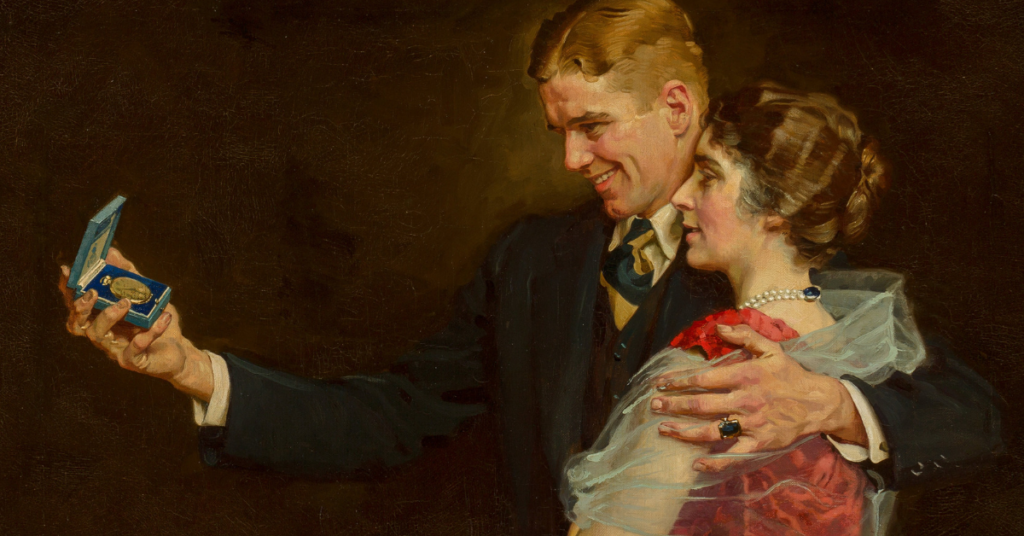Popularity often has a finite lifespan. Whether for an actor, athlete, political candidate, there usually comes a time when the public is ready for the next big thing.
Buy, Value or Appraise Your Fine Art – Paintings, Drawings, Sculptures
Bid or buy art for sale, value your item, or request a free appraisal to sell your collection.
Norman Rockwell somehow escaped such constraints. Arguably the most popular of all American illustrators and painters, his artwork was everywhere, appearing in magazines and in advertisements for five decades. When up-and-coming artists emerged, the demand for his artwork remained high. When photography technology advanced to the point that it made sense for magazines to rely more on photos than on original artwork, Rockwell maintained a full slate of assignments.
There are several explanations for Rockwell’s eduring popularity. The first, of course, is pure talent. Different people prefer varying styles of art, but it’s difficult to find anyone who won’t acknowledge that Rockwell was a supremely gifted artist. After all, the Saturday Evening Post didn’t run 323 covers over a stretch of 47 years out of some kind of altruistic nod to a legend.
Name recognition certainly helped, too. Once he was established as perhaps the country’s preeminent magazine illustrator, a painting on the cover instantly held more significance when it could be identified as a painting by Norman Rockwell.
As significant as any reason was the fact that no matter how successful and popular he got, Rockwell’s art made him appear to be one of us, a common man not unlike your children’s school teacher, or perhaps the local farmer. Instead of polished subjects so neatly put together it appears as if they might have been models sent over from Central Casting. Rockwell offered images of people to whom we all can relate, people with imperfections as simple as tousled hair or a hat sitting slightly off-center.
Heritage Auctions’ American Art auction is being held in Dallas, Texas, Nov. 8 – 40 years to the day after Rockwell died. The sale includes nine works by the iconic artist, with a range of estimates that will allow collectors of all levels to make go after an undeniable piece of American art history.
Rockwell’s willingness to challenge what was thought of as normal was a powerful element in his artwork. Consider a couple of examples in the upcoming auction:
In She Said It for a Lifetime (Man Receiving Gift Watch), his 1926 painting that appeared in advertisements for Elgin Watches, Rockwell showed a mother presenting her son with a new watch to celebrate his 21st birthday. The issue was not a parent’s love for a child, or desire to celebrate a milestone birthday. But it was a significant step to suggest that the mother, not the father, may have made the purchase of the watch. While many companies resisted the idea of catering to women as potential paying customers, Rockwell’s painting helped Elgin Watches embrace the new market of potential customers.
Norman Rockwell (American, 1894-1978)
She Said It for a Lifetime (Man Receiving Gift Watch), Elgin Watches advertisement, 1926
Oil on canvas
Estimate: $350,000 – $500,000
Rockwell’s 1953 Girl with Black Eye (The Shiner) was another image that challenged public perception. Schoolyard scraps between students were nothing new, but the common thinking was that such aggression was the domain of boys, not girls. But in this painting, Rockwell provided what at the time was a somewhat radical idea, showing a girl waiting outside the principal’s office, awaiting punishment for her role in a skirmish in which, based on the smile on her face, she clearly was the victor.
Norman Rockwell (American, 1894-1978)
Girl with Black Eye (The Shiner), The Saturday Evening Post cover study, 1953
Oil on photographic paper laid on panel
Estimate: $200,000 – $300,000
The Rockwell selections in this auction are a small fraction of the work he produced, but offer evidence explaining his enduring career and long-lasting popularity. His extraordinary talent, coupled with his ability to see the world around him through a lens just about everyone would consider realistic, are major reasons why his works remain as popular as ever.
